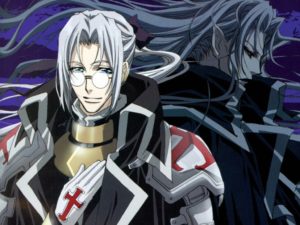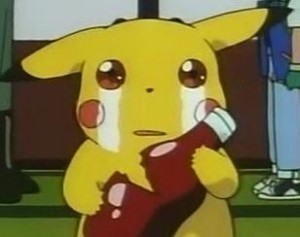In the back room of the shop today, I came across a magazine highlighting the Comic Book Legal Defense Fund‘s new library guide for understanding manga. Specifically, the title is CBLDF Presents Manga: Introduction, Challenges, and Best Practices. The cover of the magazine has a wonderful full-color piece of CLAMP art from the lauded series Chobits in which Chi is holding a tiny, dancing Persocom.
After reading the article, I was reminded of a young woman who came into the shop and scoffed at the manga shelves remarking on the “weird kids in school who read those things”. I was taken aback hearing her remark such a thing as she held an Astroboy manga in her hand. Astroboy is a classic that extended boundaries, and took off in the states. They even made a feature length children’s film about him a few years ago. I wondered – had she forgotten how many classics actually originated from Japan?
Did she realize that American favorites like Transformers, Voltron, Vampire Hunter D, and Gundam all originated in Japan. That they all began as “those books the weird kids at school read”? What about Sailor Moon? I don’t know a person who HASN’T seen an episode of Sailor Moon. Or how about your favorite games: Super Mario Bros., Legend of Zelda, Super Smash Bros.? Hell, even the Sega and Nintendo consoles came from Japan – and each and every one is infused with the same culture and story-telling found in the latest manga volume.
I’m passionate here, because I began to love anime and manga nearly ten years ago. I was about 10 at the time, and it was an entirely new and strange medium to be sure. But my love of reading kept almost nothing out of my hands, and it was difficult to pull me out once my nose was in a book. It was there that I learned something – that while immersing myself in the entertainment medium of a culture that seems absolutely foreign from my own, I wasn’t reading things much different from my beloved Harry Potter collection, or the selection I had picked from the school library. Sure, some cultural clues were different, the food looked insane, and …is that pointy thing a nose– why are her eyes so big? Wait, this story seems familiar… isn’t this a Greek tragedy?
There seems to be this preconceived notion that manga is either strange big-eyed girls in sailor suits wielding samurai swords, or straight-up porn, and that it all looks the same. I’m going to be the first person you hear arguing against that. Yes, pornographic manga exists (and yes, some of it features characters that are younger than what American standards would dictate is acceptable). Yes, there are strange big-eyed girls in sailor suits wielding samurai swords (High School of the Dead is a great example). And yes, there is a vast array of genres: horror, drama, romance, action, mystery, magic, even non-fiction! As for all of it looking the same – well, it’s easier to demonstrate that by showing.
It won’t take a rocket-surgeon to point out that one of these things is not like the other.
Or, to put it in words that might sound more familiar to an American comic readers ears, Golden Age Flash vs. Modern Flash artwork. Clearly, the two are worlds apart. Even something like The Walking Dead is going to be vastly different from what you’re seeing in Infinity right now. The idea that comics can be classified in sweeping gestures is experienced with American comic readers as well. How many times have you rolled your eyes as you heard someone exclaim “I didn’t even know they made comics that weren’t about super heroes!!!“?
It’s at this point that I ask you to take a step with me and say the following words: “A manga volume is a COMIC BOOK”.
I’m going to do another crazy thing and ask you to stick with me and actually view one of these backward-printed books as a comic book.
Pick up a volume. Open it.
Now that you’ve learned to read a manga, since I’m sure you opened it like any old book and were inevitably greeted with a giant STOP! sign, we can begin.
Important Safety Tips:
- Manga reads RIGHT to LEFT. Backwards from what you would normally be doing. There are reasons for this – primarily this is done to preserve the original artwork. Japanese is read right to left, and so panels on the page are drawn accordingly. It has been found that “flipping” the artwork using a computer can sometimes create strange idiosyncrasies on the page.
- Cultural clues and gestures will be different! For many, it seems as if body language and gestures are exaggerated in manga and anime – and to a small extent they are, much like in a cartoon or comic. However, gestures such as clapping hands in front of the face and bowing to eat, not making eye contact, or the classic “tug on eye, stick tongue out” gesture (one of ridicule or disapproval) are common practice for the Japanese.
- Knowing the genre in which you are reading is VITAL. Just like there’s a comic for everyone (kids, grownups, grandma, the perv down the street), the same will assuredly be true of the manga reader. It’s important to make sure that your entry genre will likely suit you. And, if it doesn’t – to keep trying! You certainly haven’t fallen in love with every single comic you’ve read, but that didn’t stop you from trying another one!
- Keep an open mind, and enjoy the experience!
Once you’ve picked a genre, I would suggest looking into popular titles. Some incredibly popular titles that transcend gender and age are Bleach, One Piece, Full Metal Alchemist, Inu Yasha, Ruroni Kenshin, Dragon Ball and Sailor Moon. These are generally noted as classics. Inu Yasha and Full Metal Alchemist were my first loves in the anime world. Fruits Basket was my first love in the manga world. My first manga was a book called Tokyo Mew Mew, and while it was cute and enjoyable, I never felt the need to continue the story beyond the first volume. There’s where the importance of genre kicked in. After years of reading anything that appeared interesting, I finally discovered that my true manga love takes place in the complex genre of Philosophy and Net-Based Virtual Reality. This is where you’ll find my 3 favorite series of all time: Ghost in the Shell, Accel World, and Neon Genesis Evangelion.
A great thing about manga is that many popular series end up becoming animated for television! In many cases, you won’t be in the boat you’re in with many of your comics – wishing for a t.v. serialization or movie. It’s also nice because Japanese censorship will generally make many of these appropriate for younger audiences. Anime airs during regular television hours, sometimes even during prime-time hours, in Japan. After all, they’re just cartoons (with a generally broadened age/interest gap).
Just like comics, the manga world comes with all the trimmings for the collector: comic volumes, action figures, toys, fan fiction, t.v. shows, online communities, video games … the works. And it can certainly open your eyes to new ideas, cultures, stories and levels of fandom.
Also, I want to thank you for putting up with my rant up top. Everyone can get a little spirited about things they love, right? I just don’t want to get dirty looks when they see the manga mixed in with my comics! I’ve come to learn that a great story is still great – even if you find it on a trashy fan fiction site, comic book, manga, magazine or scratched on toilet paper!
For all things Manga, #getyourfix with Em at Cosmic Comics!
Suggested Manga for the American Comic Reader:
- Bleach
- Naruto
- Ruroni Kenshin
- One Piece
- Full Metal Alchemist
- Chobits
- Fruits Basket
- Lone Wolf and Cub
- Skip Beat
- High School of the Dead
- D-Gray Man
- Detective Conan
- Loveless
- Initial D
- The Meloncholy of Haruhi Suzumiya
- DN Angel
- Ah My Goddess
- Trigun
- Death Note
- Soul Eater
- Tengen Toppa Gurren Lagann
- Card Captor Sakrua
- Magic Knight Rayearth
- Chrono Crusade
- Yu-Gi-Oh
- K-On
- Ouran Highschool Host Club
- Dragon Ball / Dragon Ball Z
- Hellsing
- Love Hina
- Akira
- Hikaru No Go
- Yu Yu Hakusho
- Samurai Champloo



Comment with WordPress, Twitter, or Facebook